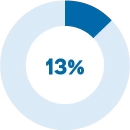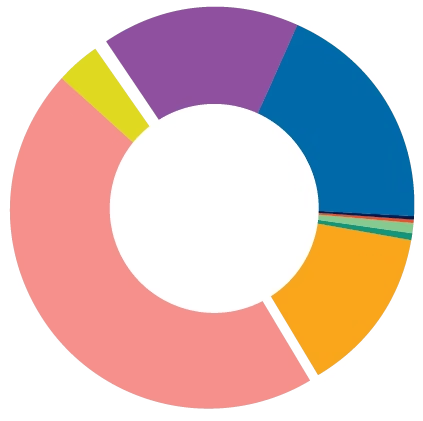
Unfortunately, the demand for quality care far outweighs the supply, so many families struggle to access and afford the care options they want or need. While there are several federally funded programs that provide working families with access to quality child care opportunities, limited funding leaves many eligible children unserved. The impacts of these challenges extend beyond families and carry over to the workplace. As a direct result, the national economy loses $122 billion annually in the form of lost earnings, productivity, and revenue.
2,716,856
Children 5 & Under
62%
Children 5 & Under with All Available Parents in the Workforce
Data not available
Licensed Child Care Centers in 2023
Data not available
Licensed Family Child Care Homes in 2023
40%
Gap in the Supply of Child Care vs. the Potential Need
$17B
Estimated Economic Impact of Infant-Toddler Child Care Challenges Each Year
CHILD CARE & DEVELOPMENT
BLOCK GRANT (CCDBG)
639,963 CHILDREN 5 & UNDER ELIGIBLE
75,950 CHILDREN 5 & UNDER SERVED

ELIGIBLE CHILDREN 5 & UNDER SERVED
CHILD CARE & DEVELOPMENT
BLOCK GRANT (CCDBG)
639,963 CHILDREN 5 & UNDER ELIGIBLE
75,950 CHILDREN 5 & UNDER SERVED

ELIGIBLE CHILDREN 5 & UNDER SERVED
CHILD CARE & DEVELOPMENT
BLOCK GRANT (CCDBG)
639,963 CHILDREN 5 & UNDER ELIGIBLE
75,950 CHILDREN 5 & UNDER SERVED

ELIGIBLE CHILDREN 5 & UNDER SERVED
STATE-FUNDED PRE-K
204,733 CHILDREN ENROLLED

3-AND 4-YEAR
OLDS SERVED

$1.15B CCDBG and Mandatory Funds
$1.36B Head Start and Early Head Start (includes AIAN HS/EHS when applicable)
$4M PDG B-5
$26.7M MIECHV
$58.8M IDEA Part C
$42.2M IDEA Part B, Sec. 619
$961.2M TANF Early Care and Education
$0 TANF Transferred to CCDBG
STATE INVESTMENT
$3.2B State-Funded Pre-K
$247.9M CCDBG State Match
$1.2M PDG B-5 State Match
Program quality varies substantially within and across states.
Quality child care and early learning programs rely on a strong workforce, but low pay makes it difficult to recruit and retain educators. In California, child care workers earn $17.92 per hour ($37,270 annually).
Teacher-child ratios are crucial for ensuring safety, quality, and individual attention. Licensed center-based care providers participating in CCDBG are required to have the following ratios:
The state’s pre-K program met 4.4/10 of NIEER’s Quality Standards Benchmarks, which represent minimum standards to support quality preschool programs.
Preschool Development Grant Birth Through Five (PDG B-5) is a competitive federal grant designed to improve states’ early childhood systems. California’s PDG B-5 accomplishments include:
The Child and Dependent Care Tax Credit (CDCTC) directly helps working parents offset the cost of child care.
In its current form, the credit only reaches a small percentage of families and has been swiftly outpaced by the escalating cost of child care as it lacks any adjustment for inflation.
Last permanently updated in 2001, the current credit averages
$500-$600 a year.
2020
2021
The CDCTC was temporarily expanded and made refundable for one year in response to the pandemic.
TODAY
The temporary expansion expired; the CDCTC reverted back to 2001 levels.
NOTE: Major provisions of the Tax Cuts and Jobs Act of 2017 (TCJA) expire at the end of 2025, giving Congress the opportunity to modernize the CDCTC and other tax provisions to better help working families offset the cost of quality child care.
Notifications
